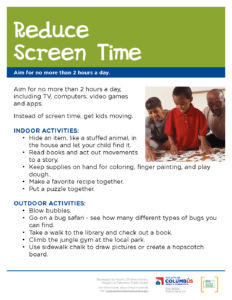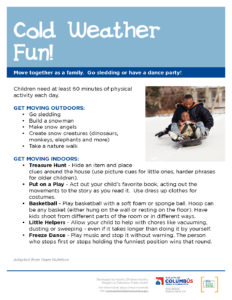Active Play
For young children, physical activity means active play. Active play is a child’s context for learning. It helps them explore their world and figure out how they fit into it. Active play helps children grow healthy bodies with strong bones and muscles. Many young children in Cuyahoga County live in environments where there are few opportunities for active play. Sometimes their neighborhoods are unsafe. Sometimes they don’t have the resources that they need to make play happen. Even still, some children lack a role model to teach them how to play.

Healthy Activity | Our Goal:
Early Ages Healthy Stages Coalition will support and expand our network of partners who seek to provide increased opportunities for active play for young children in Cuyahoga County.
Healthy Activity | Strategies for Change: EAHS is working to implement the following strategies to change the landscape of healthy activity for all young children.
The problem. Young children in Cuyahoga County are not getting the recommended amount of physical activity. The American Academy of Pediatricians recommends no screen time for children younger than 2, and 2 hours daily for children older than 2. In the child care setting, recommendations are 30 minutes per week. Like healthy eating habits, preferences for active lifestyles start around age 2 and build the foundation for healthy activity habits as children age. The 2014 Youth Risk Behavior Study found that 51% of Cuyahoga County 7th and 8th graders get the recommended amount of physical activity per week. (PRCHN, 2014)
- Our Objectives: What we will do.
- Our Actions: How we will do it.
- Our Outcomes: How we will measure success.
- Promote National Screen Free Week, collecting outcomes and input from multiple coalition members during National Screen Free Week 2017.
- Plan and orchestrate events for National Screen Free Week for the following program years.
- Provide resources, materials, and technical assistance to programs and institutions participating in National Screen Free Week.
- Track outcomes for number of participants and projects completed, as well as an evaluation of attitudes of those participating in the projects.
- Measuring the number of programs participating in activities in collaboration with EAHS
- Creation of a social marketing campaign
- Utilizing social media to track online traffic of the social media campaign
- Measuring the number of programs participating in the social media campaign
- Our Objectives: What we will do.
- Our Actions: How we will do it.
- Our Outcomes: How we will measure success.
- Identify strategic partners and institutions throughout Cuyahoga County that are interested in establishing shared use agreements for early childhood activity.
- Develop a model in collaboration with these institutions and current tool kits for a shared use “Partnership Agreement” that is specific to early childhood wellness.
- Identify sites that are available to children, families, and early care and education providers and share event information on an ongoing basis.
- Generate an updated map of early childhood shared use sites and collect data on use.
- Creation of new toolkit or modification of existing toolkit
- Measuring the number of new shared use sites
- Measuring the number of ECE centers participating
- Our Objectives: What we will do.
- Our Actions: How we will do it.
- Our Outcomes: How we will measure success.
- Hold town hall forums and community meetings within different neighborhoods throughout Cuyahoga County to identify people and places that would have a desire to improve existing spaces.
- Identify local businesses and subject matter experts willing to provide donations of materials and/or in-kind support.
- Seek funding support for grants and subcontracts for which community organizations, recreation centers, and community development corporations may apply.
- Distribute funding and evaluate short and long term use patterns.
- Measuring the number of spaces updated for safe and active play
- Measuring the amount of funding raised for community grants
- Measuring the amount of funding distributed
Healthy Activity | Systems Change Success Story:
Cleveland Department of Recreation sponsors National Screen Free Week activities at all 24 Recreation Centers throughout Cleveland.
 Staff members at The City of Cleveland Recreation Department are our local experts in all things physical activity. Over the past few years, Director Jill Lemmerman and her team have been working to make sure that recreation centers serve not only the physical health of the children, but also promote a healthy whole child. In the spring of 2017, EAHS began planning for our first official National Screen Free Week observation. We shared the National Screen Free week pledges and activity ideas and called on all of our partners what they could do to make Screen Free Week 2017 a success. The City of Cleveland Recreation Department answered the call and celebrated without screens at all 24 centers throughout Cleveland. Employees took the Pledge and gave kids attending their programs ideas about what they would be doing without screens. Kids who attended programs took Screen Free Pledges and made decorative wall displays. Baskets were put out for kids to deposit their phones and other devices and spend at least the 2 hours that they were at the Recreation Centers unplugged from their devices and plugged in to the world around them. The Recreation Centers will continue to be key leaders in National Screen Free week for EAHS.
Staff members at The City of Cleveland Recreation Department are our local experts in all things physical activity. Over the past few years, Director Jill Lemmerman and her team have been working to make sure that recreation centers serve not only the physical health of the children, but also promote a healthy whole child. In the spring of 2017, EAHS began planning for our first official National Screen Free Week observation. We shared the National Screen Free week pledges and activity ideas and called on all of our partners what they could do to make Screen Free Week 2017 a success. The City of Cleveland Recreation Department answered the call and celebrated without screens at all 24 centers throughout Cleveland. Employees took the Pledge and gave kids attending their programs ideas about what they would be doing without screens. Kids who attended programs took Screen Free Pledges and made decorative wall displays. Baskets were put out for kids to deposit their phones and other devices and spend at least the 2 hours that they were at the Recreation Centers unplugged from their devices and plugged in to the world around them. The Recreation Centers will continue to be key leaders in National Screen Free week for EAHS.
Active Play Working Group:
Co-Facilitators: Cheryl Johnson, Tiny Footprints Childcare Center
Healthy Activity Strategic Planning Handouts:
Sources:
CPST, C. G. (2014, January March 1, 2017). Environmental and Policy Approaches to Increase Physical Activity: Community Scale urban design and land use policies. Retrieved from Community Guide for Preventive Services Task Force: https://www.thecommunityguide.org/sites/default/files/assets/PA-Environmental-Community-Scale-Urban-Design-Land-Use.pdf
CPST, C. P. (2011, October March 1, 2017). Health Communication and Social Marketing: Health Communication Campaigns That Include Mass Media and Health-Related Product Distribution. Retrieved from Community Preventive Services Task Force: https://www.thecommunityguide.org/sites/default/files/assets/Health-Communication-Mass-Media.pdf
CPST, C. P. (2014, January March 1, 2017). Behavioral and Social Approaches to Increase Physical Activity: Enhanced School-Based Physical Education. Retrieved from Community Preventive Services Task Force: https://www.thecommunityguide.org/sites/default/files/assets/PA-Behavioral-School-based-PE.pdf
CPST, C. P. (2014, January March 1, 2017). Behavioral and Social Approaches to Increase Physical Activity:Social Support Interventions in Community Settings. Retrieved from Community Preventive Services Task Force: https://www.thecommunityguide.org/sites/default/files/assets/PA-Behavioral-Community-Support.pdf
CPST, C. P. (2014, January March 1, 2017). Environmental and Policy Approaches to Increase Physical Activity:. Retrieved from Community Preventive Services Task Force: https://www.thecommunityguide.org/sites/default/files/assets/PA-Environmental-Enhanced-Access.pdf
CPST, C. P. (2014, August March 1, 2017). Obesity Prevention and Control: Behavioral Interventions that Aim to Reduce Recreational Sedentary Screen Time Among Children. Retrieved from Community Preventive Services Task Force: https://www.thecommunityguide.org/sites/default/files/assets/Obesity-Behavioral-Screentime.pdf
HHS, U. D. (2012, December August 5, 2014). Physical Activity Guidelines for Americans Midcourse Review: Strategies to increase physical activity among youth. Retrieved from U.S. Department of Health and Human Services: http://www.health.gov/paguidelines/midcourse/
HHS, U. D. (n.d.). Facts and statistics. Retrieved from President’s Council on Fitness, Sports and Nutrition:: https://www.fitness.gov/resource-center/facts-and-statistics/#footnote-1
HIP-Cuyahoga, H. I.-C. (2013, March February 7, 2017). Community Health Status Assessment for Cuyahoga County. Retrieved from Health Improvement Partnership- Cuyahoga: http://www.naccho.org/uploads/downloadable-resources/Full-CHACHIPCombined-3-20-13.pdf
PRCHN, P. R. (2014). 2014 Middle School Youth Risk Behavior Survey. Retrieved from Prevention Research Center for Healthy Neighborhoods: http://www.prchn.org
USDA, U. S. (2015). Nutrition, Physical Activity, and Electronic Media Use in the Child and Adult Care Food Program; Research report on practices, challenges, and technical assistance needs. Washington D.C.: USDA.





